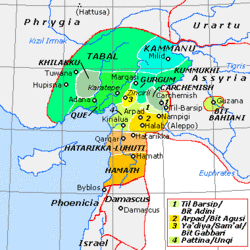
Back Tabal ALS تابال Arabic Tabal Catalan Tabal German Tabal Spanish تبال Persian Tabal French Tabaal Hungarian Tabal ID Tabal Italian
𒆳𒋫𒁄/𒌷𒋫𒁄 (Tabal: earlier) 𒆳𒂍𒁹𒁍𒊒𒋫𒀾 (Bīt-Burutaš: later) | |||||||
|---|---|---|---|---|---|---|---|
| Early 1st millennium BC–713 BC | |||||||
 Tabal among the Neo-Hittite states | |||||||
| Capital | Artulu | ||||||
| Common languages | Luwian | ||||||
| Religion | Luwian religion | ||||||
| Government | Monarchy | ||||||
| Great King (earlier) King (later) | |||||||
• r. unknown – c. 837 BC | Tuwattīs I | ||||||
• r. c. 837 BC – unknown | Kikki | ||||||
• r. c. mid 8th century BC | Tuwattīs II | ||||||
• r. c. 740 BC – 730 BC | Wasusarmas | ||||||
• r. 730 BC – c. 726 BC, c. 721 BC | Ḫulliyas | ||||||
• r. c. 721 BC – 713 BC | Ambaris | ||||||
| Vassal of the Neo-Assyrian Empire (c. 740s - 713 BC) Province of the Neo-Assyrian Empire (713 - 705 BC) | |||||||
| Historical era | Iron Age | ||||||
• Established | Early 1st millennium BC | ||||||
• Tabalian campaign of Shalmaneser III | 837 BC | ||||||
• Submission to the Neo-Assyrian Empire | c. 740 BC | ||||||
• War against Prizuwanda | mid-8th century BC | ||||||
• Deposition of Wasusarmas | c. 730 BC | ||||||
• Deposition of Ḫulliyas | c. 726 BC | ||||||
• Restoration of Ḫulliyas | c. 721 BC | ||||||
• Reorganisation into Bīt-Burutaš | c. 718 BC | ||||||
• Annexation by the Neo-Assyrian Empire | 713 BC | ||||||
| |||||||
| Today part of | Turkey | ||||||
Tabal (Neo-Assyrian Akkadian: 𒆳𒋫𒁄 and 𒌷𒋫𒁄[1][2][3]), later reorganised into Bīt-Burutaš (Neo-Assyrian Akkadian: 𒆳𒂍𒁹𒁍𒊒𒋫𒀾[4][5]) or Bīt-Paruta (Neo-Assyrian Akkadian: 𒂍𒁹𒉺𒊒𒋫[4][6]),[7] was a Luwian-speaking Syro-Hittite state which existed in southeastern Anatolia in the Iron Age.
- ^ "Tabalu [TABAL] (GN)". Textual Sources of the Assyrian Empire. Open Richly Annotated Cuneiform Corpus. Ludwig Maximilian University of Munich.
- ^ "Tabalu [TABAL] (GN)". Ancient Records of Middle Eastern Polities. Open Richly Annotated Cuneiform Corpus. Ludwig Maximilian University of Munich.
- ^ D'Alfonso 2012, p. 180.
- ^ a b "Bit-Purutaš [1] (GN)". Textual Sources of the Assyrian Empire. Open Richly Annotated Cuneiform Corpus. Ludwig Maximilian University of Munich.
- ^ "Bit-Purutaš [1] (GN)". Sargon II. The Royal Inscriptions of the Neo-Assyrian Period. Open Richly Annotated Cuneiform Corpus. Ludwig Maximilian University of Munich.
- ^ "Bit-Purutaš [1] (GN)". The Correspondence of Tiglath-Pileser III and Sargon II from Calah/Nimrud. State Archives of Assyria Online. Open Richly Annotated Cuneiform Corpus. Ludwig Maximilian University of Munich.
- ^ Weeden 2017, p. 725.